

Katsukawa Shunshô (勝川春章)
|
Katsukawa Shunshô (勝川春章), whose original name was Katsumiyagawa Yūsuke, was born circa 1726. His year of death is often reported inaccurately as 1792 (he died, in fact, on the 8th day of the 12th month in Kansei, a date on the lunar calendar that corresponds to January 19, 1793 on the Western calendar). Shunshô studied with Miyagawa Shunsui (宮川春水 active c. 1740s–1760s), son and student of Miyagawa Chôshun (宮川長春 1683-1753). (Early on, he sometimes signed as "Miyagawa Shunshô.") Shunshô also studied painting with Kô Sûkoku (1730-1804), a talented Edo-based artist whose style developed from both Kanô school painting and ukiyo-e. Shunshô's other gô (art names: 號) included Jûgasei, Ririn, Yûji, Kyokurōsei, and Rokurokuan. On many prints, he used a jar-shaped seal enclosing the character hayashi ("forest": 林), which earned him the nickname "Tsubo" ("jar": 壸). Shunshô designed yakusha-e (actor prints: 役者絵) almost exclusively (nearly all as hosoban or narrow-prints, 細判), along with over 50 sumô-e (wrestler prints: 相撲絵), a few musha-e (warrior prints: 武者絵) and a number of bijinga (beautiful women prints: 美人画), both in single-sheet and ehon (picture-book: 絵本) formats. Moreover, he was a superb painter of bijinga. There are, as well, among his illustrated books some shunga (erotica: 春画).
_hitokidori_(sukeroku)_630h.jpg) |
| Shunshô: "Sukeroku," Part II of Hitokidori harutsuge Soga (人来鳥春告曽我), 2/1764 (Left) Ôtani Hiroemon III as Hige no Ikyû, (Right) Ichikawa Raizô I as Hanakawado no Sukeroku |
Starting in the 1760s , Shunshô revitalized actor portraiture with the introduction of readily recognizable facial likenesses (nigao, 似顔) that superseded the works of the earlier Torii artists who had relied on more generalized features. Shunshô's individualized portraits launched a new era in actor print design, as from then on his disciples and later the Utagawa school of artists followed suit, making accurate and well-drawn nigao a prerequisite for successful yakusha-e. The earliest recorded single-sheet print design by Shunshô appears to be from 2/1764, a diptych portraying Ichikawa Raizô I (市川雷蔵) as Hanakawado no Sukeroku (花川戸の助六) and Ôtani Hiroemon III (大谷廣右衛門) as Hige no Ikyû (髭の伊久) in "Sukeroku, part two of the play Hitokidori harutsuge Soga (Soga Play — Announcement of the spring season by the bush warbler: 人来鳥春告曽我) at the Nakamura-za, Edo. Both prints have only the hayashi artist seal without signature. Surviving kabuki records in the Kabuki nenpyô (v. III, p. 543 and Kabuki nendaiki (p. 298) appear to support the dating of this diptych and thus also confirm that it is the earliest known full-color print (nishiiki-e or "brocade print": 錦絵), preceding Suzuki Harunobu's earliest nishiki-e published more than a year later in the summer of 1765. However, it is very difficult to find any other prints by Shunshô pre-dating 1768, which suggests further research is needed for the date of 2/1764 to prove unassailable.
After the diptych shown above from 2/1764, it was during the years 1768-69 that Shunshô seems to have first produced actor prints in any numbers. Two examples below demonstrate the visual impact of his design skills along with a most appealing color palette (selected either by the artist or the publisher, or collaboratively). Below on the left, Ichikawa Danjûrô IV (市川團十郎) is shown performing as Kagekiyo (景清) in Soga moyô aigo no wakamatsu (The Soga design and loving care of young pines: 曽我(衣+我)愛護若松) in 1/1769 at the Nakamura-za, Edo, in one of the numerous adaptations of the Soga monogatari (Tales of the Soga brothers: 曽我物語), conflated with a Kagekiyo mono (Plays about Kagekiyo: 景清物) regarding the historical Heike general Taira no Kagekiyo (平 景清 died 1196). Below on the right, Ichimura Uzaemon IX (市村宇左衛門) plays the role of Hanagata Shumenosuke (花形主馬之助) in the dance interlude Imayô Musume Dôjô-ji (A Contemporary maiden of the Dôjô Temple: 今様道成寺) during the premiere of Edo no hana wakayagi Soga (Flowers of Edo: A new young Soga: 江戸花陽向曽我), a New Year production at the Ichimura-za, Edo. In the dance, Princess Kiyo obsessively pursues the priest Anchin. When he flees from temptation and hides under a temple bell (seen in Shunshô's print at the upper left), she changes into a serpent, coils herself seven times around the bell, and melts the bell with venomous fire, killing the priest.
_danjuro_as_kagekiyo_630h.jpg) |
_uzaemon-as-shumenosuke_630h.jpg) |
| Shunshô: Ichikawa Danjûrô IV as Kagekiyo Play: Soga moyô aigo no wakamatsu, 1/1769 |
Shunshô: Uzaemon IV as Hanagata Shumenosuke Dance/Play: Imayô Musume Dôjô-ji, 1/1769 |
Shunshô's approach to yakusha nigao, along with that of Ippitsusai Bunchô, was further established through one of the most important woodblock-printed books in the history of ukiyo-e, the Ehon butai ôgi (Picture book of stage fans: 絵本舞台扇). Carved by Endo Matsugorô (遠藤松五郎) and published in three volumes by Kariganeya Ihei (雁金屋伊兵衛) in 1770, the volumes were disseminated widely, even having an impact far away in Kamigata (Osaka-Kyoto), where most notably the Osaka master Ryûkôsai Jokei took inspiration from Shunshô-Bunchô method of facial likenesses (似顔). Surviving copies offer two-page spreads with one actor on each page, as in the example shown below. (Surviving bound copies do not always have the designs in exactly the same order.) Each actor is identified in two places, by his geimei (stage name: 芸名) and by his haimyô (poetry pseudonym: 俳名 or haigô, 俳号). The names on all the portraits are left in reserve against printed blue backgrounds, nearly always faded to a buff color, as below. On the left, Shunshô depicted Nakamura Nakazô I (中村仲蔵, Shûkaku 秀鶴) and below right, Nakamura Utaemon I (中村歌右衛門, Kachichi 歌七). Both artists used their seals, so we have only the hayashi jar-shaped seal for Shunshô on these two portraits. The placement of half-length figures within ôgi (fans: 扇) would prove to be a prelude to an important series of similar portraits by Shunshô in the much larger single-sheet double-aiban format (see the following discussion).
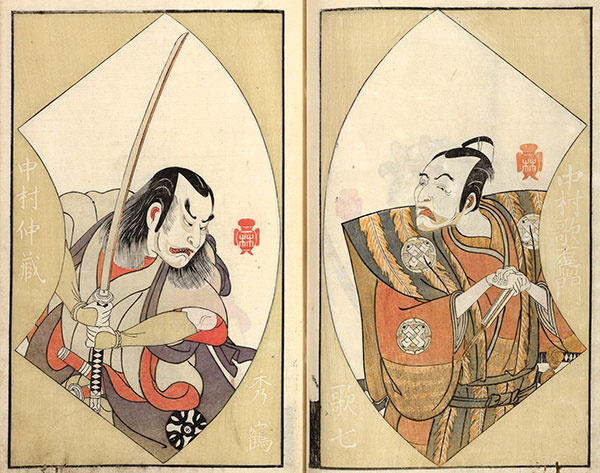 |
| Shunshô: Ehon butai ôgi (Picture book of stage fans: 絵本舞台扇), 1770 (L) Nakamura Nakazô I (中村仲蔵), Shûkaku (秀鶴); (R) Nakamura Utaemon I (中村歌右衛門), Kachichi (歌七) |
Shunshô's series Azuma ôgi (Fans of the East: 東扇), published from 1775 to 1782, was a ground-breaking enterprise in the history of ukiyo-e. Expanding upon his compositional device of placing half-length portraits of actors within fan-shaped cartouches in the woodblock-printed book Ehon butai ôgi (1770; see above), Shunshô now did the same in a very large, single-sheet, double-aiban format (approx. 460 x 330 mm). The result was a stunning advance in the visual impact of realistically rendered actor likenesses. Each print in the series includes the same instructions for use and advertising for other designs. The prints were meant to be used to create ôgi (folding fans: 扇), either by cutting them out and pasting onto older fans (or to newly fabricated fan-ribs), or for cutting and pasting onto byôbu (folding screens: 屏風). Presumably, a great many customers followed the instructions and most impressions are now lost to posterity. Twenty-three designs are currently known, 20 by Shunshô, one by Utagawa Toyoharu (1735-1814), and two by Isoda Koryûsai.
One example from Azuma ôgi is shown below left. Ôtani Hiroji III (大谷廣治) performs as a defender of the weak and oppressed, called an otokodate (chivalrous commoner: 男伊達), possibly in the role of Satsuma Gengobei (さつま源吾兵衛) in Iro moyô aoyagi Soga (Green willow Soga of erotic design: 色模様青柳曽我) at the Nakamura-za in 2/1775. This is the standard design format for the series (there are only a few exceptions), with the instructions given at the lower left and Shunshô's signature (here in a cursive style) above the actor. This particular impression also has the actor's name inscribed by hand in red, written by a previous collector (there are two other designs in the series with similarly inscribed impressions). The tiny red seal in the lower left corner is the Hayashi Tadamasa dealer/collector seal.
A design from the following year (below right) portrays Nakamura Nakazô I (中村仲蔵) as Ono Sadakurô (斧定九郎) in Act V of Kanadehon chûshingura (Copybook of the treasury of loyal retainers: 假名手本忠臣蔵) in 5/1776 at the Nakamura-za. The illustrated episode is the Yamazaki Highway scene in which Ono Sadakurô, a former retainer but now a rogue and a thief, is shown drawing his sword as he prepares to murder Yoichibei and steal his money-purse. Most unusual, the actor's skin is printed with an "unnatural" pink-tinted white, perhaps meant to evoke Sadakurô's evil nature. Note that in this and the previous Gengobei design, both torsos bend along the curve of the fan, imparting a feeling of motion, at least when viewed as they oriented here (not as they would be if mounted as fans).
_hiroji-as-gengobei_310w.jpg) |
_nakazo-as-sadakuro_421h.jpg) |
| Shunshô: Ôtani Hiroji III as Satsuma Gengobei (?) Series: Azuma ôhi, 2/1775 (double-aiban) |
Shunshô: Nakamura Nakazô as Ono Sadakurô Series: Azuma ôhi, 5/1776 (double-aiban) |
Further explorations into possible themes for yakusha-e led Shunshô to produce a small but pioneering series (8 known designs) of single-sheet views of actors backstage. Such a subject would have been fascinating to fans of kabuki, as the so-called gakuya ("comfort rooms": 楽屋) or dressing rooms on the second and third floors of the theaters were strictly off-limits to the uninvited public. The various rooms served specific functions, such as the ishô-beya (wardrobe room) or ishô-gura (costume storeroom). In Shunshô's series (and eventually in similar works by other artists), actors were sometimes depicted at moments of leisure while wearing no makeup or costumes. In other examples, backstage scenes depicted actors preparing for performance (applying makeup, donning wigs, and so forth). The untitled series seems to have been published over a few years, possibly circa 1780-83. Roughly concurrent with this set, Shunshô also produced in 1780 a monochrome (sumizuri) ehon titled Ehon yakusha natsu no Fuji (Picture book of actors — Mt. Fuji in summer: 絵本役者夏富士), presumably suggesting a correspondence between a snowless sacred mountain and actors without makeup.
One example from the backstage series is shown below left. The actor Sawamura Sôjûrô III (沢村宗十郎) stands in his dressing room (part of his name is visible on the name-board at the upper right) while using a towel to dry behind his ear, a conventional gesture in ukiyo-e for having returned from the bath. Crouched before him is Segawa Kikunojô III (瀬川菊之丞), a superstar onnagata ("woman's manner," an actor specializing in female roles: 女方 or 女形). This casual scene takes place after their performance, and whereas Sôjûrô has bathed and will soon put on his street clothes, Kikunojô will remain dressed in female attire, as onnagata were expected to behave as women even away from the stage. A glimpse such as this into the private world of actors would have excited the fans of both actors. Below right is a scene also showing Segawa Kikunojô III, this time visiting Ichikawa Danzô IV (市川團蔵) in his dressing room while a hair dresser touches up a wig. Near the partially visible name-board reading Danzô (團蔵) is a pair of stage swords mounted to a wall rack. Danzô smokes an extremely long kiseru (pipe: 煙管), a status symbol and, if need be, a weapon, while Kikunojô leans slightly toward him, holding an uchiwa (rigid fan: 團扇 or 団扇) patterned with his kaemon (alternate crest: 代紋) of a butterfly. Kaemon were personal crests generally reserved solely for a particular actor (different from jômon, 定紋, fixed crests used by an entire acting lineage).
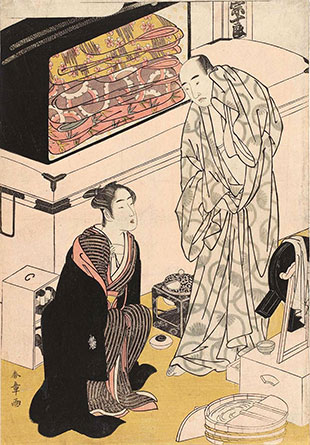 |
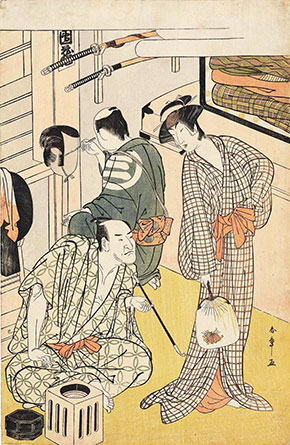 |
| Shunshô: Actors backstage, c. 1780-83 Sawamura Sôjûrô III and Segawa Kikunojô III |
Shunshô: Actors backstage, c. 1780-83 Segawa Kikunojô III and Ichikawa Danzô IV |
Early in his career, Shunshô also designed bijinga, some clearly in the manner of Suzuki Harunobu. In 1771 he produced 48 koban (a small format in a variety of sizes, in this case half an aiban sheet) associated with the classic Ise monogatari (Tales of Ise: 伊勢物語), an anonymous tenth-century collection of 143 brief episodes serving as fictional headnotes to 209 poems. Although Ise subjects had appeared earlier in ukiyo-e black and white prints or book illustrations, Shunshô appears to have been the first to use the full-color print process (nicknamed nishiki-e, or "brocade print": 錦絵) for Ise subjects in single-sheet prints when he provided the Ise designs for the publisher Urokogataya Magobei.
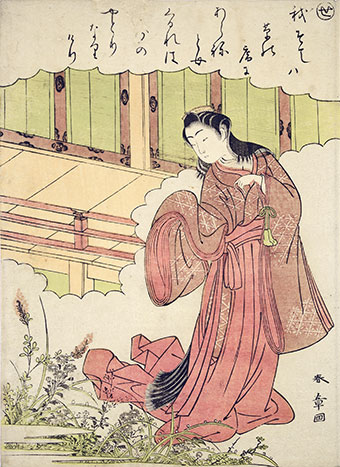 The first part of the series was titled Fûryû nishiki Ise monogatari nijûyo mai ("The Tales of Ise in fashionable brocade on 24 sheets": 風流錦絵伊勢物語 二十四枚). Then a second set of 24 additional designs was issued the following year, but these are not commonly found today, possibly because of the loss of the prints and woodblocks in a widespread fire that struck Edo in 2/1772, damaging the publisher's workshop. Both Ise sets have proven to be important as early indicators of Shunshô's skills in areas other than actor portraiture. In many of these classical Ise subjects Shunshô introduced strong narrative elements that distinguish his work from the more atmospheric productions of Harunobu.
The first part of the series was titled Fûryû nishiki Ise monogatari nijûyo mai ("The Tales of Ise in fashionable brocade on 24 sheets": 風流錦絵伊勢物語 二十四枚). Then a second set of 24 additional designs was issued the following year, but these are not commonly found today, possibly because of the loss of the prints and woodblocks in a widespread fire that struck Edo in 2/1772, damaging the publisher's workshop. Both Ise sets have proven to be important as early indicators of Shunshô's skills in areas other than actor portraiture. In many of these classical Ise subjects Shunshô introduced strong narrative elements that distinguish his work from the more atmospheric productions of Harunobu.
The image on the immediate right is an example from the rare second set of Ise subjects. The print includes the kana character for "se" within a circle (each of the 48 designs in the Ise series has one of the iroha or Japanese syllabary characters) and a poem from Episode 56, which describes a man tortured by love, compelling him to express his feelings in the poem (shown at the top of the print). As night approaches, the dew (a conventional poetic metaphor for tears) clings to his sleeve as it might to the thatched roof of a simple hut.
The style of drawing the young beauty appears to be a blend of Sukenobu, Suzuki Harunobu, classical Tosa school album paintings, and Shunshô himself. The drawing of the face is Shunshô's own, and although it may remind us of Harunobu, Shunshô's approach to feminine physiognomy seems a bit earthier by comparison.
During the years when the designs from Azuma ôgi (discussed above) were being published, Shunshô also explored other modes of presenting yakusha-e. One of these was the full-length aiban double portrait for shosagoto ("pose business": 所作事), dance interludes or sequences within plays on kabuki programs. Shunshô was, in effect, expanding beyond the typical (though not exclusive) single-figure-per-hosoban sheet by adopting the aiban format and pairing up actors, often in contrasting poses. The example below left portrays amateur actors as Shunkan Sôzu (しゆんくわん僧都) and Kameô's Wife (nyôbô) Oyasu (亀王女房おやす ) in Hime komatsu ne no hi no asobi (Pine seedlings and an excursion on the day of the rat: 姫小松子日の遊) from the series Geiko zashiki kyôgen (Parlor theatricals by geisha: 芸子座敷狂言). The nigao (facial likenesses: 似顔) are intriguing, for while the geisha's physiognomy is idealized and thus not meant to represent a particular woman, the male performer most likely derives from an actual person, probably someone from Shunshô's social or professional milieu. Amateur theatricals were quite popular during the Edo period. They were fostered by published ômuseki ("Parrot rocks" or kabuki speeches: 大石) or serifu (stage speeches: 台詞) used by amateurs in imitation of their favorites professional actors.
The presence of a bijin in Shunshô's parlor-theatrical design brings us back to other bijinga by Shunshô. His models for female portraiture were, early on, not only the aforementioned of Suzuki Harunobu, but also Isoda Koryûsai and Kitao Shigemasa. In the example below right, two geisha of the Tachibana-chô (橘町) stroll across a wooden bridge. The title Kitsugai no kunpû (The fragrant breeze of Orange-blossom Street: 橘街ノ薫風) appears in the upper right cartouche. The larger of the two red seals in the lower right corner is that of the dealer Wakai Oyaji (わか井おやぢ Wakai Kenzaburô, 1834-1908); the other belonged to Wakai's interpreter and assistant, the collector/dealer Hayashi Tadamasa (林忠正 1853-1906). The slim beauties — who are, after all, the "fragrant breeze" of the print title — promenade with a proper, upright gait, in not-too-ornate robes (now faded) characteristic of the geisha's iki (stylish refinement: 粋 or 粹).
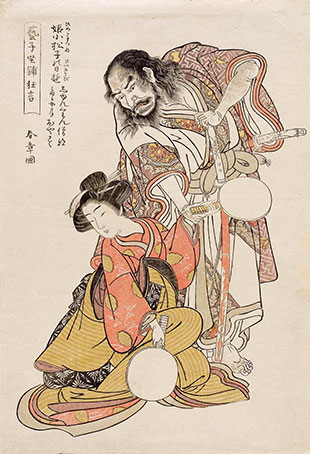 |
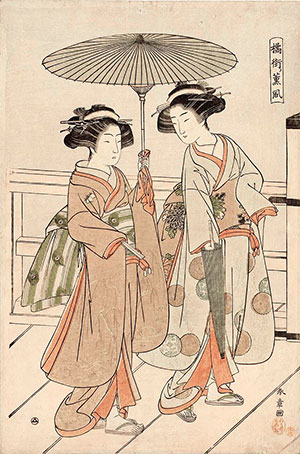 |
| Shunshô: Amateur actors in Hime komatsu Series: Parlor theatricals by geisha, c. 1775-81 (aiban) |
Shunshô: Geisha of Tachibana-chô, c. 1775-79 (aiban) Title: "Fragrant breeze of Orange-blossom Street " |
Among Shunshô's ehon (picture books: 絵本), none surpass his collaboration with Kitao Shigemasa on Seirô bijin awase sugata kagami (Comparisons of the beauties from the pleasure houses — a mirror of their lovely forms: 青楼美人合姿鏡). Co-published at the New Year in 1776 by Tsutaya Jûsaburô and Yamazakiya Kinbei, and engraved by Inoue Shishichi, the three volumes include a preface by Tsutaya that says, among other things, "The successful print artists Kitao [Shigemasa] and Katsukawa [Shunshô] have now depicted graceful courtesans in the various seasons, showing their manners and customs within elegant surroundings at the brothels." [trans. by Osamu Ueda] The two artists worked on this project in virtually indistinguishable styles, so it is exceedingly difficult to identify the particular artist responsible for a given scene. The example below, from volume one, portrays three courtesans from the same house (onajiku: おなじく), the Chôji-ya brothel (丁子屋), in the Yoshiwara during early summer. Karauta (から歌) is standing while she watches and listens to Hinazuru (ひな鶴 = 雛鶴) playing the tsuzumi (small hand drum: 皷 or 鼓). Meanwhile, Meizan (名山) listens to the call of a cuckoo flying above a pine tree in the garden below. These women, whose faces are of a type and not meant to be nigao or actual likenesses, exemplify the idealized convention for portraying higher-ranking pleasure women in the 1770s, who within their servitude inhabited lives of proscribed luxury. Seirô bijin awase sugata kagami has long been considered a masterpiece of book illustration and a conduit into the daytime lives of elite courtesans, shown engaging in various activities and entertainments, with a focus on material lavishness.
_600w.jpg) |
| Shunshô: Courtesans Hinazuru, Karauta, and Meizan of the Chôjin-ya Title of illustrated book (ehon): Seirô bijin awase sugata kagami (青楼美人合姿鏡), 1776 |
Shunshô, although best known for introducing a new form of facial realism in yakusha-e (actor prints: 役者), also produced paintings of bijin ("beautiful women": 美人) that are considered among the best of the Edo period. His paintings on this theme began to appear around 1775 or so. (The total of confirmed paintings by Shunshô totals about 160 for all genres, with many more likely lost.) Sometimes, dating Shunshô's bijin paintings within a short range of years can be accomplished by examining the style of signature and kakihan (writing seal of cipher: 花押) along with the manner of depicting the women and their hairstyles. In the kakejiku (hanging scroll: 掛軸) shown below, those factors suggest a date of circa 1780. The early-summer scene depicts a wistful young woman dressed in costly robes from either a samurai clan or a wealthy merchant family standing under a willow tree. The poem at the top was composed and inscribed by Fûdo, a kyôka (playful verse: 狂歌) poet, and reads: "The willows would leaf in profusion in an answer to the water's invitation." [trans. from Metropolitan Museum of Art] The audience for paintings such as these would have been, typically, the tsû (connoisseurs: 通) of the "floating world" in Edo. These sophisticates would have appreciated not only the skill required to render such an appealing portrayal, but also the nuances of meaning when such images were paired with poems, as they often were. The paintings and poems were part of a social and intellectual exchange within the milieu of the floating world, whose artists, writers, poets, scholars, actors, entrepreneurs, samurai, well-educated merchants, and (occasionally) geisha and courtesans were avid participants. From the present example and many others, we can see why a saying from Shunshô's time claimed, "A Shunshô painting is worth a thousand pieces of gold." [quoted by Richard Lane]
_890h.jpg) |
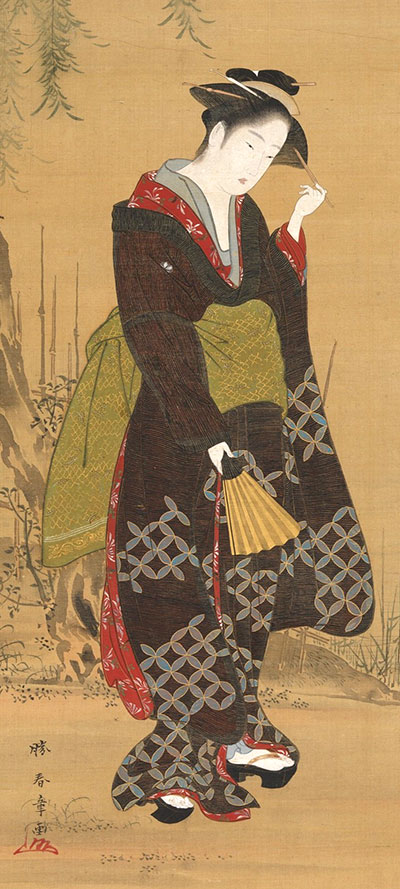 |
| Shunshô: Bijin under a willow tree Scroll painting, c. 1780 |
Shunshô: Bijin under a willow tree (detail) Scroll painting, c. 1780 |
Yet another area of achievement for Shunshô was his contribution to the genre of sumô-e (wrestler prints: 相撲絵). On the lower left, two wrestlers for the West side, Edogasaki Genji (江戸崎源治) and Mikuniyama Hyôdayû (三國山兵太夫) are shown during the dohyô-iri (土俵入り), the ring-entering ceremony. After the match ends, the referee (gyôji: 行司) announces "Winner East" or "Winner West" rather than declaring the wrestler’s name. Each rikishi wears a keshô-mawashi) (tassled apron: 化粧廻し), which in the Edo period was worn during both the dohyô-iri and the wrestling bout. Today, it is used solely during the dohyô-iri; a mere mawashi (thick-waisted loincloth: 廻し) is worn during the match. Shunshô's series, with 11 known designs published by Matsumora and spanning the period from 3/1873 to 11/1874, is distinctive in the verticality of the compositions. In all the prints, the rikishi (wrestler: 力士) fill the pictorial space and stand together rather upright in their postures. The example shown below depicts Edogasaki in profile, the only rikishi portrayed in that manner in the series.
Aside from the high quality of his sumô-e, Shunshô designed one of the earliest sumô-e pairing of a rikishi with a teahouse waitress. On the lower right, we see the champion Onogawa Kisaburô (小野川喜三郎 1758-1806) who in a tournament in 2/1782 defeated the seemingly invincible Tanikaze Kajinosuke (谷風梶之助 1750-96). Nevertheless, Tanikaze ultimately won 21 top-division championships and is today recognized as Japan's fourth yokozuna (highest rank in sumô: 横綱). Onogawa became the fifth yokozuna, although his record of top-tournament wins was only seven. Shunshô's design was later altered with a different head and (updated) hairstyle for the waitress and with Shunshô's signature removed. The tentative dating of the print to around 1783 has been based on Onogawa's having a full head of hair; later portrayals in the early 1790s clearly show a receding hairline. He retired from the ring in 1797.
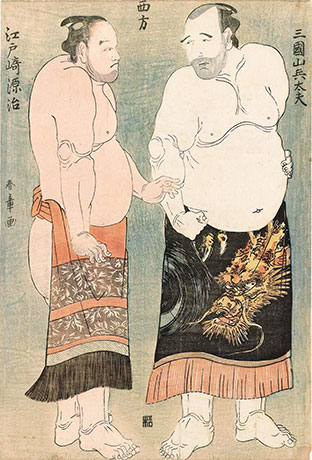 |
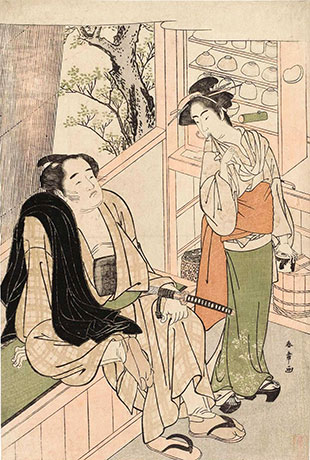 |
| Shunshô: Edogasaki Genji and Mikuniyama Hyôdayû Wrestlers (West side) during the dohyô-iri (1783-84) |
Shunshô: The wrestler Onogawa Kisaburô and a teahouse waitress, 1783 (ôban) |
Shunshô continued working until a few months before his death. Two selections from his later oeuvre are shown below. On the left, Segawa Kikunojô III (瀬川菊之丞) performs a shishi-mai (lion dance: 獅子舞) in Shakkyo no shosa (Stone-bridge dance: 石橋の所作) in 3/1789 at the Ichimura Theater. Shakkyô refers to the bridge in the Nô play of the same name in which a traveler falls asleep beside a stone bridge and dreams of a lion dancing among peonies. On the right, 1792(8mo) Ichikawa Ebizô I (市川蝦蔵), formerly Ichikawa Danjûrô V (市川團十郎 until 11/1791), performs as Kemushi Baba (毛虫ば) in Mukashi mukashi tejiro no saru (むかし/\掌白猿) in 8/1792 at the Ichimura Theater. In both of the prints below, the style of Shunshô's signature has turned cursive and is quite different from his earlier signature forms. Also, the 1792 print bears a kiwame ("approved": 極) seal first used alone for censor approvals on ukiyo-e prints from October 1790 through January 1800, then with other seals until 1845. The first type of censor seal (kiwame) appeared soon after the 5/1790 edict issued by the government requiring censorship of ukiyo-e books and prints before they could be published legally. The publishers' guild therefore established a censor (gyôji: 御璽) system in which designs were approved and sealed in various ways.
_kikunojo_shakkyo_630h.jpg) |
_ebizo_as_kemushi_baba_630h.jpg) |
| Shunshô: Segawa Kikunojô III performing a lion dance, 3/1789 (hosoban) |
Shunshô: Ichikawa Ebizô I performing as Kemushi Baba, 8/1792 (hosoban) |
Today, we acknowledge not only Shunshô's important prints and paintings, but also his pupils (Katsukawa Shunchô, Rantokusai Shundô, Shun'ei, Katsukawa Shun'en, Katsukawa Shunjô, Shunkô, Katsukawa Shunsei, Katsukawa Shunsen, Katsukawa Shuntei, Tamagawa Shunsui, and Shunzan). Even the great Hokusai (1760-1849) began in Shunshô's studio (signing as Shunrô) in 1779, although he changed his name to Sôri in late 1794 and left the Katsukawa studio in 1795, quickly developing his own vivid style of ukiyo-e design. © 1999-2020 by John Fiorillo
BIBLIOGRAPHY
- Asano, Shûgô: "Shunshô's 'Fûryû nishiki-e Ise monogatari (Tales of Ise), Introduction of Material," in: Ukiyo-e Geijutsu, vol. 96 (1988), pp. 32-44.
- Bickford, Lawrence: Sumo and the Woodblock Print Masters. Tokyo & New York: Kodansha, 1994.
- Clark, Tim: "Shunshô's 'Fûryû nishiki-e Ise monogatari (Tales of Ise), Part Two," in: Ukiyo-e Geijutsu, vol. 100 (1991), pp. 72-81.
- Clark, Tim and Ueda, Osamu: The Actor's Image. Chicago: The Art Institute of Chicago, 1994, pp. 184-191.
- Gookin, Frederick: A Master Artist of Old Japan: Katsukawa Shunshô, 1726-179; A Review of his Life and Works. [Unpublished manuscript] 1931, 2 volumes.
- Ihara, Toshirô (ed.): Kabuki nenpyô (Chronology of kabuki: 歌舞伎年表), Vol. 3. Tokyo: Iwanami Shoten, 1958, p. 543.
- Katz, Janice and Hatayama, Mami: Painting the Floating World: Ukiyo-e Masterpieces from the Weston Collection. Art Institute of Chicago, 2018, pp. 156-163 (including "A Word on Inscription" Writing and Image on Bijinga Paintings," by Helen Nagata, pp. 156-159).
- Lane, Richard: Images from the Floating World: The Japanese Print. New York: Dorset Press, 1982, pp. 116-120.
- McCullough, Helen Craig: Tales of Ise: Lyrical Episodes from Tenth-Century Japan. Stanford: Stanford University Press, 1968.
- Shunshô. Ukiyo-e taikei (Great Collection of Prints from the Floating World — Shunshô: 浮世絵大系春章), vol. 3. Tokyo: Sueisha, 1976.
- Smith, Henry: "Actor Prints: Shunshô, Bunchô, and the Katsukawa School," in: The Actor's Image, Ueda & Clark, 1995, pp. 20-2.
- Succo, Frederick: Katsukawa Shunsho (Haruaki). Plauen, Vogtland: Schulz & Co. 1922.
- Tsuchihashi, P.: Japanese Chronological Tables from 601 to 1872. Tokyo: Sophia University, 1952, p. 102.
- Yoshida, Teruji (ed.): Kabuki nendaiki (Chronicle of kabuki: 歌舞伎年代記). Tokyo: Hôbunkan, 1926, p. 298.
Viewing Japanese Prints |